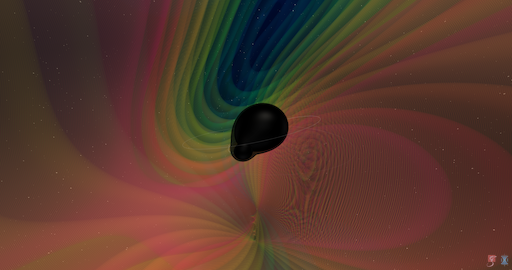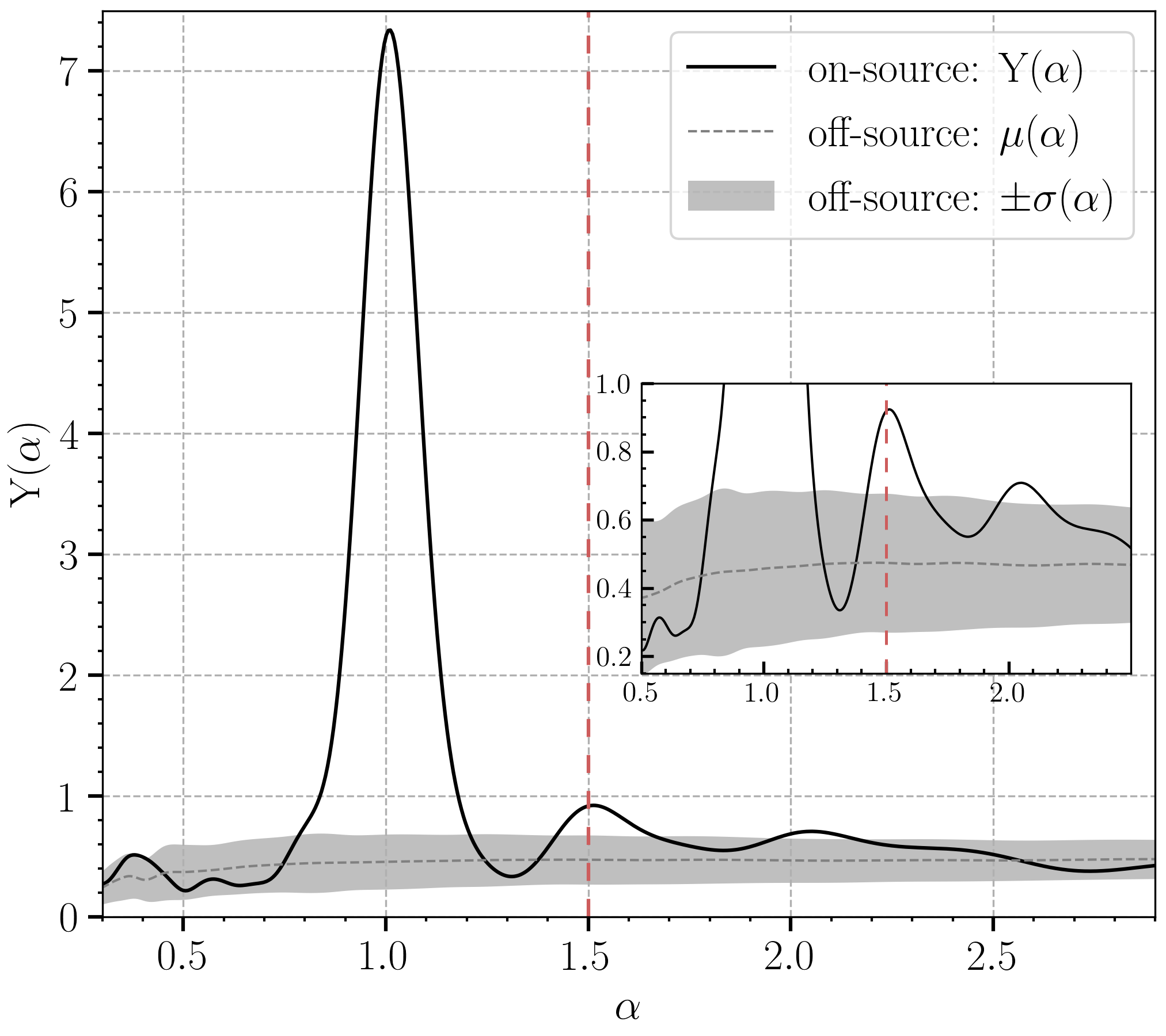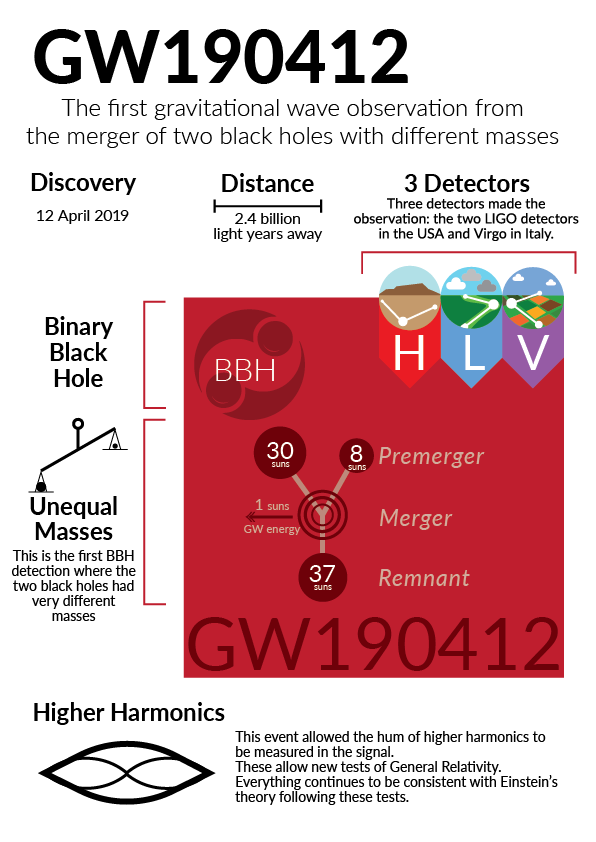On April 12, 2019, just after 11:00 AM (IST), the LIGO Scientific Collaboration and Virgo Collaboration observed gravitational waves produced by the inspiral and merger of two black holes.
This event, dubbed GW190412, was observed with both LIGO detectors (at Hanford, Washington and in Livingston, Louisiana USA) as well as the Virgo detector (located in Cascina, Italy).
Scientists from several Indian research institutes participated in the analysis and made key contributions to this discovery.

The GW190412 detection paper on LIGO Document Control Centre
Highlights of the discovery
- First binary black hole merger where the masses of the two black holes are definitively unequal — one black hole in the system is more than 3 times heavier than the other.
- This asymmetry in masses has important ramifications: we can better measure the distance to the source, and inclination of the system and the speed of rotation (spin) of the heavier black hole, etc.
- The larger black hole was found to be spinning at about 40% of the maximal spin allowed by general relativity. Also, GW190412 occurred almost 2.5 billion lightyears away from Earth!
- In addition, the unequal masses of GW190412 enabled researchers to verify a fundamental prediction of Albert Einstein’s General relativity: that gravitational waves include more than one harmonic of the orbital frequency.
- Important to our understanding of binary black hole population: observation of this single event tells us that black hole systems with unequal masses are relatively common, and that we should expect to observe many more such systems in future.
Numerical simulation of a black-hole binary merger with asymmetric masses and orbital precession
Video: Numerical simulation of two black holes that inspiral and merge, emitting gravitational waves. One black hole is 3.5x more massive than the other and spins, which makes the orbit precess. The simulated gravitational wave signal is consistent with the observation made by the LIGO and Virgo gravitational wave detectors on April 12th, 2019 (GW190412).
- The "apparent horizon" of the black holes in the simulation are shown in black. At 1:09 the simulation finds an enveloping apparent horizon that signals the two black holes have merged.
- The gravitational radiation is translated to colors around the black holes. The colors transition from blue, representing weak radiation, to red, representing strong radiation. Specifically, the coloring represents the real part of the gravitational wave strain with its inverse radial scaling removed for visualization. The strain is computed from the simulation’s extrapolated waveform, which is shown at the bottom of the screen.
Credits: © N. Fischer, H. Pfeiffer, A. Buonanno (Max Planck Institute for Gravitational Physics), Simulating eXtreme Spacetimes project
Indian Contributions
Scientists from several Indian research institutes participated in the analysis and made critical contributions to this discovery.
Notably,
- Scientists from IIT Gandhinagar and Chennai Mathematical Institute collaborated with LIGO-Virgo researchers to analyze data which resulted in the convincing discovery of the faint, sub-dominant components of the signal, as predicted in Einstein’s theory of gravitation.
Gravitational radiation from compact binaries is predominantly composed of a quadrupolar component, analogous to the main sound that you hear when plucking a guitar string. However, just like musical instruments, gravitational radiation is also predicted to ring at higher harmonics. The asymmetric masses of the GW190412 system allows for these subtle (faint) components of the signal to be better “heard”. A new technique was developed by this Indian team to separate out the signal components (see Image) using time-frequency spectrograms. This was followed by a sophisticated statistical analysis for detecting the fainter higher multipole component. The chances of a false-positive is determined to be less than 0.06 %, which underlines the high significance of the detection.
In future, the relative intensity of the subtle signal components (multipoles) may help to better disentangle the properties of coalescing black holes.
- Researchers from the International Centre for Theoretical Sciences (TIFR), Bangalore were part of another analysis in collaboration with researchers in the LIGO and Virgo Collaboration that verified the consistency of the signal with the prediction of General Relativity. This analysis checks the compatibility between the low- and high-frequency parts of the observed signal.
- The waveform models, accounting for the effect of higher multipoles of the signal, were developed by various Indian groups at ICTS-TIFR, Bangalore, CMI-Chennai, IIT Madras and Raman Research Institute Bangalore, over the past three decades. Such theoretical models have played a central role in this discovery. Several physical effects observed in this new LIGO discovery were studied in various contexts in the past by the Principal Investigators of the research groups at IIT Gandhinagar, CMI Chennai, ICTS-TIFR Bangalore, IUCAA Pune, IIT Bombay and IIT Madras.

Image: The energy of different components of the signal (multipoles) is shown in the figure. The variable α along the horizontal axis denotes different multipoles: α = 1 denotes the dominant multipoles and α = 1.5 denotes the second strongest multipole. The vertical axis represents the cumulative energy for each multipole. The large peak shows the energy from the dominant quadrupolar mode, and the smaller peak shows the detectable energy from the next strongest multipole component. The inset zooms in on these peaks.
A rich legacy
Indian scientists have made pioneering contributions to the gravitational-wave (GW) science over the last three decades. In particular, they have contributed to the fundamental algorithms crucial to search for inspiraling binaries in noisy data from multiple detectors, in computing the theoretical waveforms of GW signals by solving Einstein’s equations, in separating astrophysical signals from numerous instrumental and environmental artefacts, in the interpretation of joint gravitational-wave and gamma-ray observations, tests of Einstein’s theory and many other aspects of the data analysis.
The Indian team in LIGO includes scientists from CMI Chennai, DCSEM Mumbai, ICTS-TIFR Bangalore, IISER Kolkata, IISER Pune, IIT Bombay, IIT Gandhinagar, IIT Hyderabad, IIT Madras, IPR Gandhinagar, IUCAA Pune, RRCAT Indore and TIFR Mumbai.

